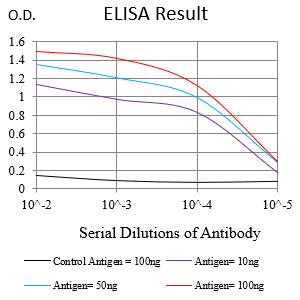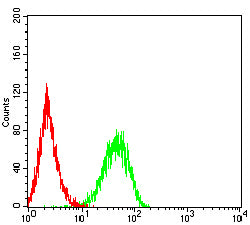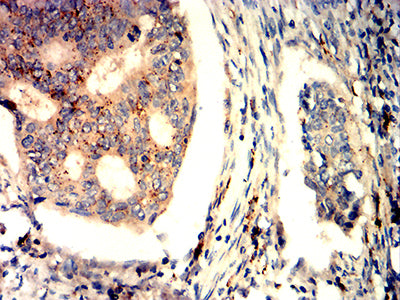



| WB | 1/500 - 1/2000 | Human,Mouse,Rat |
| IF | 咨询技术 | Human,Mouse,Rat |
| IHC | 1/200 - 1/1000 | Human,Mouse,Rat |
| ICC | 技术咨询 | Human,Mouse,Rat |
| FCM | 1/200 - 1/400 | Human,Mouse,Rat |
| Elisa | 1/10000 | Human,Mouse,Rat |
| Aliases | P1; PFP; HPLH2 |
| Entrez GeneID | 5551 |
| clone | 8A8C10 |
| WB Predicted band size | 61.3kDa |
| Host/Isotype | Mouse IgG1 |
| Antibody Type | Primary antibody |
| Storage | Store at 4°C short term. Aliquot and store at -20°C long term. Avoid freeze/thaw cycles. |
| Species Reactivity | Human, Mouse |
| Immunogen | Purified recombinant fragment of human PRF1 (AA: extra 148-372) expressed in E. Coli. |
| Formulation | Purified antibody in PBS with 0.05% sodium azide |
+ +
以下是关于PRF1抗体的3篇参考文献及其摘要:
1. **"Perforin and human diseases"**
- **作者**: Voskoboinik I., et al.
- **摘要**: 该综述总结了穿孔素(Perforin-1.PRF1)在细胞毒性T细胞和NK细胞介导的免疫反应中的作用,重点讨论了PRF1基因突变导致的免疫缺陷疾病(如家族性噬血细胞性淋巴组织细胞增生症,FHL2),并提及PRF1抗体在诊断和研究中的应用。
2. **"Mutations in the perforin gene in patients with hemophagocytic lymphohistiocytosis"**
- **作者**: Stepp S.E., et al.
- **摘要**: 本研究通过基因测序和免疫组化分析,揭示了PRF1基因突变与噬血细胞综合征(HLH)的关联,利用PRF1抗体检测患者细胞中穿孔素蛋白的表达缺失,为HLH的分子诊断提供了依据。
3. **"Functional consequences of PRF1 mutations in familial hemophagocytic lymphohistiocytosis"**
- **作者**: Côte M., et al.
- **摘要**: 文章通过体外实验和流式细胞术,结合PRF1抗体对患者细胞进行蛋白表达分析,发现PRF1突变导致穿孔素功能缺陷,进而引发细胞毒性功能障碍和过度炎症反应。
4. **"Immunohistochemical detection of perforin in cytotoxic lymphocyte-associated human diseases"**
- **作者**: Ueda H., Sano T.
- **摘要**: 研究优化了PRF1抗体在石蜡包埋组织中的免疫组化染色方法,用于检测细胞毒性淋巴细胞中的穿孔素表达,为感染、肿瘤及自身免疫疾病的病理诊断提供技术支持。
以上文献均聚焦于PRF1抗体的应用场景(如疾病诊断、功能研究)及其在揭示穿孔素生物学机制中的价值。
The PRF1 antibody targets perforin-1 (PRF1), a cytolytic protein critical for immune-mediated cytotoxicity. PRF1 is primarily secreted by cytotoxic T lymphocytes (CTLs) and natural killer (NK) cells. It plays a pivotal role in eliminating virus-infected or malignant cells by forming pores in target cell membranes, facilitating the entry of pro-apoptotic molecules like granzymes to trigger apoptosis. This mechanism is essential for controlling infections and tumor surveillance.
PRF1 antibodies are widely used in research to detect PRF1 expression in immune cells, aiding in studies of immune dysfunction. Mutations in the PRF1 gene are linked to familial hemophagocytic lymphohistiocytosis (FHL type 2), a lethal autosomal recessive disorder characterized by defective cytotoxic granule exocytosis and hyperinflammation. PRF1 antibodies help diagnose such immunodeficiencies and investigate conditions like autoimmune disorders or cancers with dysregulated cytotoxicity.
In laboratory settings, these antibodies are employed in techniques like Western blotting, immunohistochemistry, and flow cytometry to assess protein levels, cellular localization, and functional defects. Recent studies also explore PRF1's role in immunotherapy, as modulating its activity could enhance cytotoxic responses in cancer treatment. Understanding PRF1 biology via its antibody not only advances fundamental immunology but also informs therapeutic strategies for immune-related diseases.
×